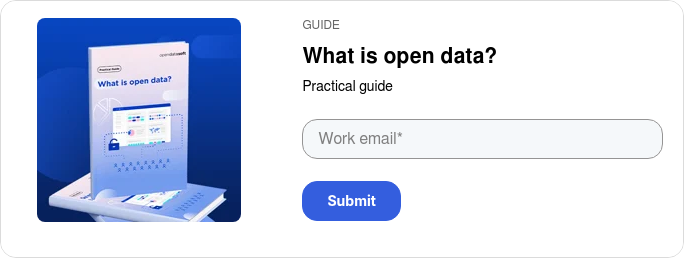2024 Open Data Maturity report – the importance of driving greater impact
How successful are governments at sharing their data with citizens and businesses? The latest Open Data Maturity report provides an overview of progress across Europe, and highlights the importance of improving data portals and measuring impact to future success

Data sharing is central to increasing productivity, improving decision-making and boosting innovation and transparency. This is particularly true when it comes to sharing public data through national open data portals. These unlock the ability to not only better engage citizens but to drive new use cases for data that generate economic, environmental and societal benefits.
Given the importance of public open data sharing, many countries and regions, including the US, EU and UK, all mandate that government bodies share their data with citizens, businesses and other public bodies. To encourage this data sharing and spread best practice, the European Commission (EC) annually benchmarks all of its 27 members, as well as candidate countries and those in the European Free Trade Association (EFTA) and has recently published its 2024 Open Data Maturity report. This blog highlights some of the key trends from the study, as well as lessons that can be learnt by organizations across the public and private sectors.
Understanding the state of open data maturity
The European Commission’s Open Data Maturity (ODM) report has now been running for ten years, and the 2024 edition is the most comprehensive yet, covering 34 countries. As well as the 27 EU members, it also surveys three EFTA countries (Iceland, Norway, and Switzerland), and four candidate countries (Bosnia and Herzegovina, Albania, Serbia and Ukraine).
In the Study, progress towards open data maturity is assessed in four key dimensions:
- Policy: the open data policies and strategies in place, national governance models for managing open data and the measures applied to implement policies and strategies.
- Portal: the functionality provided by national open data portals, how they reflect user needs, the availability of open data across different domains and the approach to ensuring the portal’s sustainability.
- Quality: the measures adopted to ensure the systematic harvesting of metadata, the monitoring of metadata quality and compliance with the DCAT-AP metadata standard, and the quality of deployment of the published data on the national portal.
- Impact: the willingness, preparedness and ability of countries to measure both the reuse of open data and the impact created through this reuse.
Policy remains the most mature dimension, scoring 91% across the EU 27, up 2% from 2023. Portal is the second most mature, but declined by 3% across the EU 27 year-on-year. Quality is the least mature area, also declining by 3% to 79%. Impact has risen in maturity to 80%, overtaking quality for the first time in the EU. Later in the blog we’ll explore the Portal and Impact scores in more detail to draw lessons and conclusions for private and public sector organizations alike.
Analyzing performance on a country-by-country level
At a top level the report shows that overall maturity has increased to an average of 80% across all 34 countries surveyed – a 1% growth from 2023. 18 countries increased their maturity year-on-year, one remained the same overall, and 15 countries experienced a decrease in their maturity scores. For 11 of these, the decrease was less than 5%. Over three-quarters of countries had a maturity score above 73%.
To demonstrate the different levels of performance the report splits countries into four clusters, with recommendations for each group:
- Trendsetters (94-100%) This group includes France, which is again the top performer, scoring a perfect 100%, followed by Poland, Ukraine, Slovakia and Ireland
- Fast-trackers (83-90%): Including Portugal, Serbia, and Norway
- Followers (74–80 %): Including Germany, Sweden, Switzerland, and the Netherlands
- Beginners: (15-69%): Including Bosnia and Herzegovina, Albania, Malta, and Iceland
A full map showing all scores can be accessed here.
The importance of improving portal features
A major factor in the drop in the Portal score was the introduction of new criteria and questions around the features offered on national open data portals. For example, previous questions around mature functionality such as filtering and download options were no longer asked. These changes reflect the growing need for portals to offer a better, more intuitive experience – essentially users, whether citizens, businesses or public agencies, want to be able to easily discover and access relevant data in the right formats for their needs. They want the same seamless experience as on an ecommerce marketplace – but in many cases portals are not delivering. Without these improvements usage is unlikely to increase, with uninviting portals putting off people from interacting and reusing data. As the report says:
As well as an appealing design, key portal features to focus on include:
Intuitive search
The ability to easily discover relevant data is central to engagement. This means that search has to be able to meet the needs of a wide range of audiences from data experts to the less technical, using advances such as AI natural language search which understands the intent behind a query. Users also need to be recommended other relevant data assets, based on their search history to give them a more complete experience and broaden their usage.
More comprehensive access to data
National open data portals have traditionally focused on official data, leading to potential gaps in some areas, with users having to visit other sites to access relevant information. This is changing, with 17 EU member states now publishing non-official data on their portal, up from 12 in 2023. However, progress needs to accelerate in order to provide users with access to complete data via a single, central portal, particularly with the introduction of new regulations to mandate national single information points (NISPs) in EU countries.
Actively promote high-value data
Through a 2023 regulation, the EU increased the focus on public sharing of High-Value Data (HVD), information with the potential to drive greater benefits to users, businesses and society. Covering data in categories such as geospatial, earth observation and environment, meteorological, statistics, companies/company ownership, and mobility, HVDs have to be available free of charge, be machine-readable and accessible via APIs and as a bulk download. 70% of EU countries actively promote HVDs, such as through special labels or sections on their portal. However, this means the remaining 30% need to catch up to better drive HVD reuse.
Provide the opportunity to rate data assets
Everyone now expects the ability to rate their purchases or experiences on the websites they visit, including data platforms and portals. Yet only half (52%) of EU countries provide the ability for users to rate datasets on their portals, usually through awarding stars or grades. Increasing the opportunity for users to provide feedback is vital, both to engage them more deeply with the portal, and also to build trust with other users and encourage greater data reuse. Rating datasets provides data owners with key information that they can then use to improve the data assets they offer moving forward.
Driving greater impact with data
National data portals were first introduced to increase transparency, providing citizens and businesses with insights into government activities and spending in order to better inform audiences and ensure accountability. While this is a vital first step, it does not fully deliver on the potential of data to create lasting impact. Achieving greater impact requires open data to be processed, reused and shared in order to maximize its value, making it available in new ways. The report highlights a range of measures to drive greater impact, including:
Better understanding user needs
Governments generate an enormous range of data assets. Choosing which to promote most strongly on national portals can therefore be a challenge. Countries are therefore adopting a range of strategies to better understand what data users are looking for in order to meet their needs more effectively. The vast majority of EU countries were able to give examples where their data had been reused across a range of areas, including 89% showing how it had enriched biodiversity and 85% how it had increased efficiency. Many are now monitoring the data that is accessed most often and the characteristics of users in order to publish and promote similar datasets, as well as collecting feedback from regular user surveys. Others are running hackathons to inspire different groups to generate new ideas around specific data types.
Sharing reuses more effectively
One of the best ways to inspire people to engage with data is to provide examples of how others have already reused it. 89% of EU countries now collect and share different reuses on their portals, with many introducing dedicated pages linking to reuses contributed by users. Publicizing successes encourages greater innovation and builds a wider community around data.
Monitoring impact
Shared effectively, government data can drive improvements in efficiency, accountability, and policymaking, and help to tackle social, environmental, and biodiversity challenges. Countries can only understand the impact of open data on these areas if they have KPIs in place to monitor and measure it. On the positive side, 82% of countries now have a measurement methodology in place, helping to drive continual improvements at both a strategic and tactical level. However, there is still scope for improvement around the impact of data reuse. For example, just 52% of countries were able to measure the impact of data on social challenges and 56% on environmental ones.
Transforming national data portals
The findings of the EC’s 2024 ODM Study highlight progress to date with government data sharing – and demonstrate where countries need to focus moving forward. Essentially, governments now understand that simply publishing data on their national portals is no longer enough – they have to deliver a user-friendly experience that is tailored to meet the needs of each of their audiences, with relevant data available in an intuitive way that mirrors that of an ecommerce marketplace. This will drive greater data consumption and spread data democratization, increasing the impact of data on wider society and delivering increased value and ROI on portals. As new regulations, such as the Data Governance Act and Data Act come into force across the EU, along with an increasing number of European data spaces across different industries, there is the opportunity and need to transform national data strategies and portals to ensure they meet changing needs in the data-driven future.





